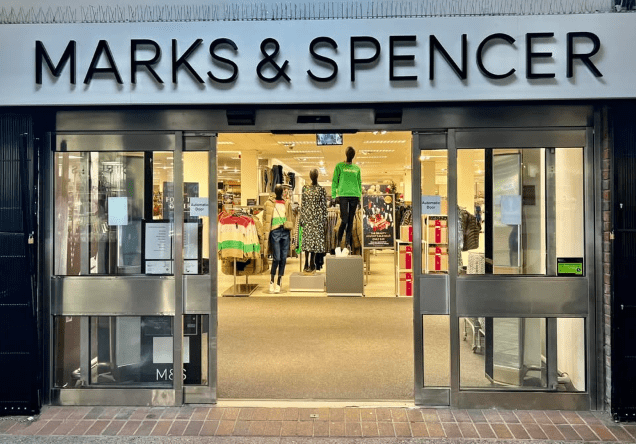Marks & Spencer has revealed a £300 million hit to its operating profit due to a recent cyberattack — but the retail giant is keen to underline its overall robust performance and future resilience.
The retail stalwart unveiled its full-year results on Wednesday, and while the figures were closely scrutinised, all eyes were on the financial fallout from April’s cyber incident.
The company admitted the attack has significantly impacted operations, especially online, and could dent profits in the current financial year by up to £300 million.
However, the blow isn’t expected to be fully absorbed. M&S stated that this figure is “before cost mitigation, insurance recovery and trading initiatives,” signalling confidence that the eventual damage will be less severe.
Cyberattack Sparks Tech Overhaul
The attack, described as “highly sophisticated,” forced M&S to temporarily shut down its webstore. That move disrupted online sales, particularly in its Fashion, Home & Beauty departments.
The company said it had been “working around the clock with suppliers and partners to contain the incident”. Despite the disruption, M&S appears determined to turn adversity into opportunity.
“We’re seeking to make the most of the opportunity to accelerate the pace of improvement of our technology transformation and have found new and innovative ways of working,” the company explained.
And it’s not stopping there. M&S is now “focused on recovery, restoring our systems, operations and customer proposition over the rest of the first half, with the aim of exiting this period a much stronger business”.
Online shopping remains heavily disrupted, with the firm warning that issues will persist through June and July. As a result, it expects increased costs around stock management in the second quarter.
Fashion, Home & Beauty’s online sales and trading profit took a hit following the webstore pause. Yet stores have proven resilient, softening the overall impact.
Strong Underlying Performance
Despite the cyber setback, the figures for the year to late March paint a positive picture.
- Adjusted profit before tax surged 22.2% to £875.5 million — the highest in over 15 years.
- However, statutory PBT slipped by 23.9% to £511.8 million.
- Food sales posted another year of strong growth, while Fashion, Home & Beauty saw revenues rise 3.5% to £4.2 billion.
The adjusted operating profit for Fashion, Home & Beauty increased to £475.3 million, up from £437.5 million the previous year.
CEO Champions Product Revamp
Chief Executive Stuart Machin credited the continued growth to improved product perception.
“Our authoritative lead in quality and value perception and much improved style credentials broadened [our] appeal and [grew] market share.”
The results back that up. Categories like jeans, knitwear, and tops saw notable growth. M&S’s Autograph premium range jumped by 47%, with men’s Autograph sales surging to nearly £200 million — a fourfold increase in just three years.
Kidswear held firm too, with growth in baby products and a focus on value through a “first price, right price” model, ditching traditional promotions.
In-store performance delivered good news. New full-line stores in Dundee and Washington Galleries exceeded expectations, trading 15% ahead of plan. Meanwhile, Fosse Park’s extension drove 20% growth in Fashion, Home & Beauty sales.
The Battersea fashion-only store trial also gained traction since opening in December 2024. It will serve as a template for future concepts, including a flagship renewal of The Pantheon on Oxford Street.
Online Ambitions and Challenges
Prior to the cyberattack, online channels were showing early signs of improvement. Adjusted for its exit from furniture, online accounted for 34% of total sales, driven by a 9% rise in active customers to 10.2 million.
Efforts to elevate the online experience included:
- Upgraded visuals and navigation
- Better availability in smaller sizes
- A 42% boost in partner brand fashion sales
High-profile collaborations with Hush, Tommy Hilfiger, and Calvin Klein helped push brand sales past £200 million.
Still, M&S admits there’s work to be done to hit its goal of 50% of Fashion, Home & Beauty sales online in the medium term. “There remains a lot more to do to create a market-leading online business.”
While international sales dipped 7.1% to £0.7 billion, M&S is pressing ahead with its global ambitions. The aim? A streamlined, capital-light omnichannel model powered by strategic franchise partners.
India remains a challenge, but a reset is underway. The company is ditching discounts in favour of full-price trading and cutting costs under new leadership.
Marks & Spencer has taken a hit, no question. A £300 million cyberattack blow is no small matter. But beneath the disruption lies a company showing resilience and readiness.
Strong in-store performance, solid financial growth, and a commitment to digital transformation put M&S on a firm footing. While short-term turbulence remains, particularly online, the retailer seems set to emerge from this chapter more agile and future-focused.
Focus Keyword: M&S cyberattack impact, M&S full year results 2025, Marks and Spencer profit report, M&S online disruption, M&S fashion sales growth






